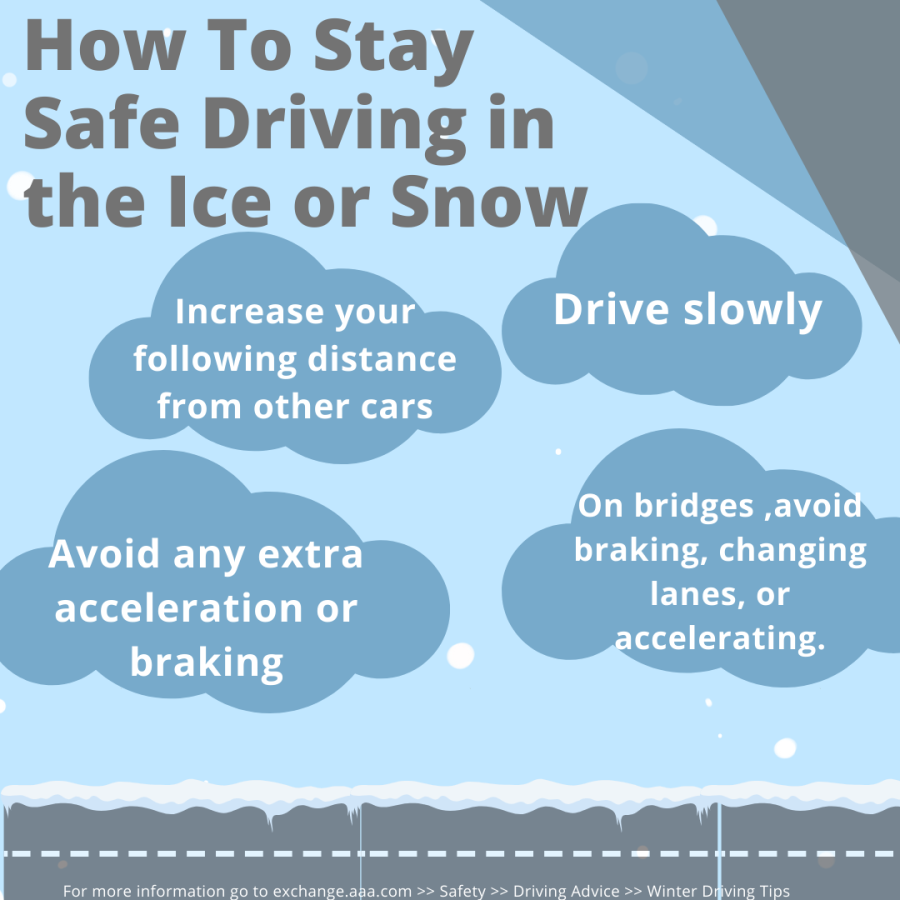Driving in Ice and Snow…Take it Slow
According to experts, these tips can keep you safer in bad weather. For more information, visit www.jdpower.com
March 3, 2022
One of the best parts of living in the midwest is the ability to experience all types of weather from snow to extreme heat to fog to intense rain. But one of the downfalls of being able to experience all those types of weather is the driving risks and accidents that are brought about because of it. According to the Federal Highway Administration, out of all the crashes a year 21% of them are weather related, that’s over 1.2 million car accidents; seriously injuring over 418,000 people a year.
Inclement weather is one of the top 10 causes of car accidents a year. Thousands of people all over the world believe they are doing the right thing when driving in inclement weather but little do they know they could be putting themselves and others in more danger without even realizing it.
Driver’s Ed. teacher, Mr. Thomas Iffrig explained one of the most common mistakes new or even experienced drivers make. “When you are driving in fog, the actual technique you’re supposed to use is turning on your low beam headlights which are your normal headlights. A lot of people turn on their high beams thinking that it’s going to help them see better through the fog, but it is actually going to make it worse. Your high beam headlights will reflect off the fog and make it more difficult to see.”
Many new vehicles have new technology that can help prevent injuries or even save lives on the road. Some are to warn the driver if they are at risk of a crash and others are designed to try and avoid a crash altogether. In addition to the new technology that is being put into vehicles, cruise control is one of the most common and convenient features offered for driving in ‘perfect’ weather conditions, however, during inclement weather cruise control is the last thing you want to use when driving.
“Some people believe it’s a good idea to set your cruise control in just a lower speed but you are actually going to want to not set your cruise control at all,” Mr. Iffrig said. “What happens is if you have your car on cruise control your transmission will make your car go at a constant speed and so, if you were to hydroplane your tires are going to continue to spin at the same speed and when you go to hit the pavement again it could cause serious issues and make it harder to gain control of your car.”
Often people’s first instinct is to slam on their breaks when met with dangerous situations but in bad weather, that can make the situation even worse. Mr. Iffrig explained, “When driving in inclement weather you want to make sure to accelerate and brake more gently; smoother starts and smoother stops. That’ll help prevent sliding on the road or even into an intersection.”
Senior Olivia Bulger explained her personal experience of getting into a car accident due to drivers not knowing proper inclement weather protocol, “It was a four car accident, the second car ran into my car and the third and fourth slammed on their brakes and slid on the ice in the middle of the road.”
According to the United States Department of Transportation there is a 47% chance the drivers in the accident with Olivia Bulger were speeding. So no matter how much of a rush you’re in to get to school or work on time, it isn’t worth getting into a crash that could be fatal.
Ever since the accident, Bulger started paying more attention to safe driving tips. “I keep space between the car in front of me and ease on the brakes.”
Mr. Iffrig also encouraged that strategy. The easiest way to be sure you are driving far enough apart, “In perfect weather, you want to be about 3 secs behind a car, for rain you want to be about 4 secs and for snow, fog, or ice you want to be around 5-6 secs behind.” A way to gauge this, is to wait for the car in front of you to pass a sign or a big hill or something of your choice, then count how many seconds until you pass that landmark.
With insurance on the rise and safety always a concern, learning how to handle yourself in the snow is a must. In St. Louis, you never know what could happen.


